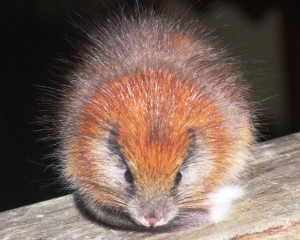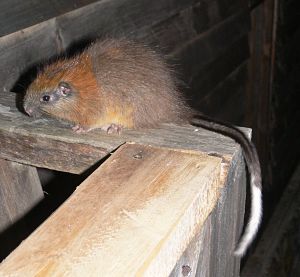New Species News: Bird and Tree Rat
Posted by: Loren Coleman on May 21st, 2011
Researchers from Madagascar and The Field Museum recently described a new bird species. They named the new bird, a forest-dwelling rail, Mentocrex beankaensis, with the genus Mentocrex endemic to Madagascar and the new species beankaensis referring to the location where the bird was found – the Beanka Forest in west central area of the island. Scientists determined the rail was a new species based on the bird’s size, plumage, and DNA.

Field Museum zoologist Steve Goodman conducted the morphological portion of the study in Madagascar along with his colleague Marie Jeanne Raherilalao, Professor at the University of Antananarivo and Association Vahatra. Nicholas Block, a graduate student with the University of Chicago who is works at The Field Museum’s Pritzker Laboratory for Molecular Systematics and Evolution, analyzed the bird’s DNA.
The discovery of the new species emphasizes the critical need to conserve the remaining dry forests of Madagascar which have been drastically reduced in size. An estimated 97 percent of the original forest cover in this portion of the island has disappeared since humans arrived some 2,500 years ago. Over the past decades these remaining dry forest areas have been the sites of numerous discoveries of plant and animal species new to science.

The Beanka Forest is a largely intact area resting on exposed limestone formation with razor-sharp pinnacle-like structures. The forest is in a remote portion of the island and has been managed since late 2007 by the Association Biodiversity Conservation Madagascar (BCM) and funded by Bioculture (Mauritius) Ltd., which has started programs for the socio-economic development of surrounding communities, forest restoration, and the conservation of the site. In the fall of 2009, the Association Vahatra, in collaboration with BCM and several other research groups working on Madagascar’s flora and fauna, organized a large-scale biological inventory of the Beanka Forest.
During this inventory, scientists discovered several new species of plants, invertebrates and vertebrates, including the new rail. Mentocrex beankaensis is the first of a series from the expedition to be named. Dr. Raherilalao commented on the discovery, saying, “Even after many decades of research, nature is always full of surprises, even for organisms such as birds that have been intensively studied. This underlies the importance of field research and biologocal inventories.”



Meanwhile, in South America, the red-crested tree rat was a “lost species,” unseen since 1898 , from the Santa Marta Mountains in Colombia, until it turned up in a nature reserve there.
“He just shuffled up the handrail near where we were sitting and seemed totally unperturbed by all the excitement he was causing,” said Lizzie Noble, a volunteer researcher at the El Dorado nature reserve in north Colombia.
The tree rat (Santamartamys rufodorsalis) was considered extinct. But after presenting itself to Noble and her colleague, Simon McKeown, on May 4, 2011, it stayed for two hours, enough for photos. The nocturnal rodent even allowed them to take close-ups snaps before wandering back into the forest.
“We’re delighted to have rediscovered such a wonderful creature after just a month of volunteering,’” said Noble, of Godalming in Surrey. “Clearly, the El Dorado reserve has many more exciting discoveries waiting for us.”
About Loren Coleman
Loren Coleman is one of the world’s leading cryptozoologists, some say “the” leading living cryptozoologist. Certainly, he is acknowledged as the current living American researcher and writer who has most popularized cryptozoology in the late 20th and early 21st centuries.
Starting his fieldwork and investigations in 1960, after traveling and trekking extensively in pursuit of cryptozoological mysteries, Coleman began writing to share his experiences in 1969. An honorary member of Ivan T. Sanderson’s Society for the Investigation of the Unexplained in the 1970s, Coleman has been bestowed with similar honorary memberships of the North Idaho College Cryptozoology Club in 1983, and in subsequent years, that of the British Columbia Scientific Cryptozoology Club, CryptoSafari International, and other international organizations. He was also a Life Member and Benefactor of the International Society of Cryptozoology (now-defunct).
Loren Coleman’s daily blog, as a member of the Cryptomundo Team, served as an ongoing avenue of communication for the ever-growing body of cryptozoo news from 2005 through 2013. He returned as an infrequent contributor beginning Halloween week of 2015.
Coleman is the founder in 2003, and current director of the International Cryptozoology Museum in Portland, Maine.










So the recently found red-crested tree rat (Santamartamys rufodorsalis) was a “lost species” up until May 4, and all the evidence mainstream biology needs to confirm its existence now is eyewitness accounts and some photos? Really?
Good thing it wasn’t a Sasquatch, because that kind of evidence just doesn’t fly when it comes to modern bipedal primates. Years of films, videos, photos, footprints and even hair samples have led biologists to dismiss solid Sasquatch evidence as junk science, even now. They want a body or bones for proof of Sasquatch; yet this singular rat, thought extinct for over 100 years, is accepted as real? On the basis of one sighting alone?
Where’s the red-crested tree rat’s DNA test? The blood and tissue samples? The hair samples? Are we supposed to accept mere photographs and anecdotes (by volunteer researchers yet!) as evidence for some creature’s existence? If so, then Sasquatch/BF is a legitimate primate species, by this logic.
Sadly, Loren and the Cryptomundo staff have again fallen for a totally biased mainstream science trap: what’s good enough to prove the existence of a bird or rat species is not good enough for proof of Sasquatch, or any other primate discoveries for that matter.
I’d guess Patterson, Gimlin, and all the other Sasquatch witnesses and researchers who came before are rolling over in their graves at science’s easy acceptance of this missing rat species. If you’ve had a Sasquatch encounter or shot videos/photos of same, this “discovery” should really burn you up.
After a 2-hour encounter, they didn’t even get plaster casts of the little guy’s prints.